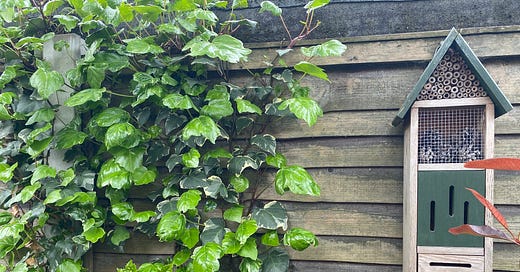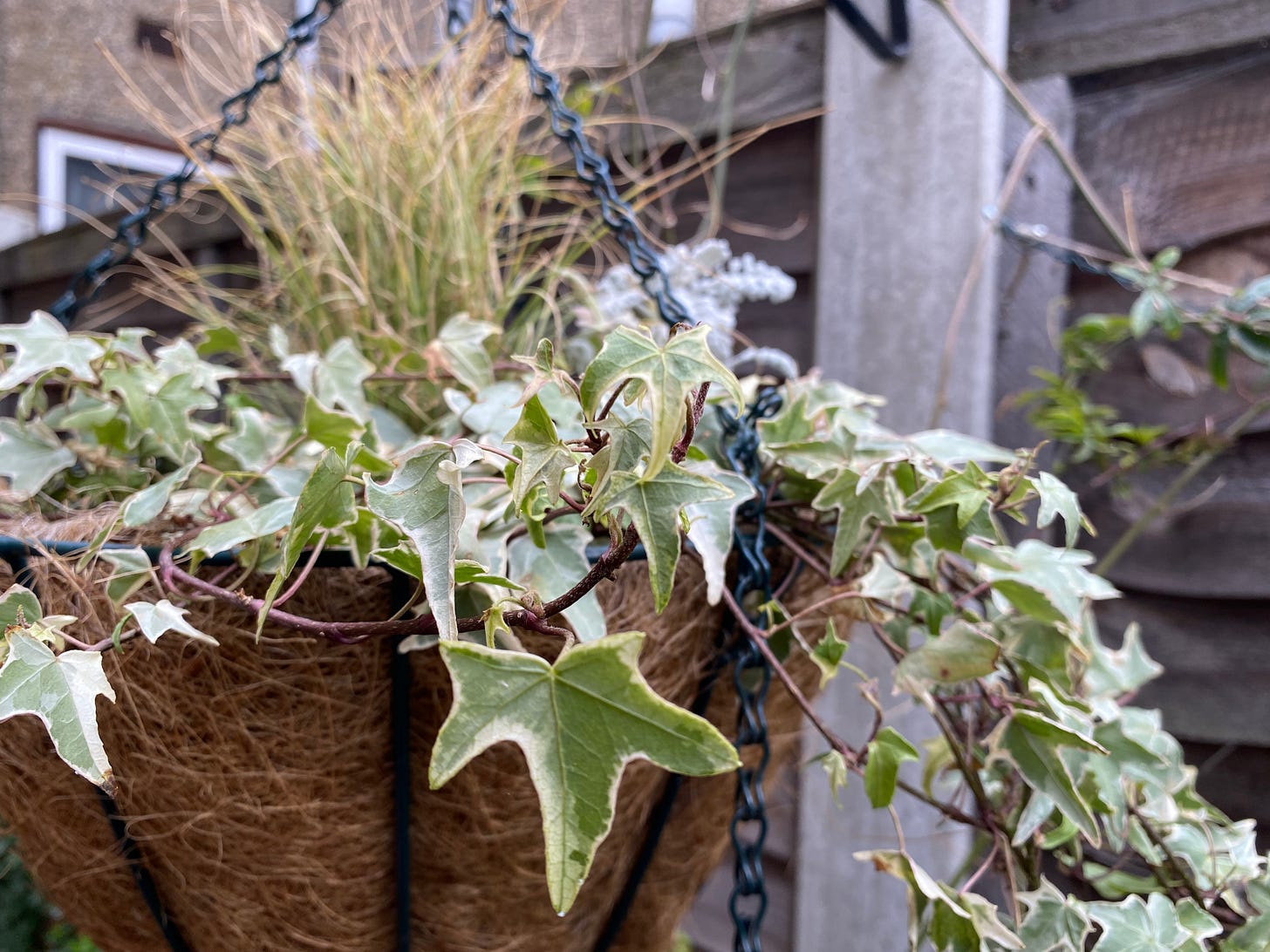In defence of ivy
At best overlooked, at worst feared, ivy has a bad rep – but for all the wrong reasons. This versatile and beautiful plant has myriad benefits, for wildlife, people and planet
You’re reading The Earthworm, a newsletter that takes a sideways look at the world of gardens, gardening, horticulture and all that good green stuff. If this is your first time here, you can catch up on anything you’ve missed by following this link. Subscribe now for free and join the community! You can also support me and my work on The Earthworm by upgrading to a paid subscription at any time – just tap the button below.
We gardeners are a fickle sort: quick to admire, quick to forget.
Spring has sprung. Everywhere you look, flowers bloom, foliage unfurls, shoots, well, shoot. Blossom floats down from the treetops, creating pixelated carpets of pink-and-white petals. And as we sow our seeds in preparation for the months of sunny abundance that are just around the corner, our sideboards, cabinets and countertops are already garnished with daffodils, tulips and hyacinths harvested from our own pots and borders.
Gardeners are always looking forwards, always awaiting the next blockbuster display. We rarely look back (except arguably in the winter, when we long for the warmth and colour of summer, but even then, I feel like we’re impatiently looking ahead to the summer-to-come, rather than appreciating the one just past).
So let’s pause to remember what our outdoor spaces looked like a few short weeks ago. Two colours dominated: green and brown. There was bare earth, full of fertile promise, and plenty of it. And then there were the hardest working plants in the business: the evergreens.
As everything else dies back, evergreens come into their own, and we are so grateful for their form and glossy colour. Until spring, that is, when our gratitude wanes and we become distracted by a more polychromatic seasonal display. By summer, we will hardly notice the evergreens, as their familiarity blinds us to them.
But these evergreens are still playing a vital role, and continue to give so much to our green spaces. And, in my mind, none more so than ivy. I love ivy. It has to be one of the most versatile, attractive and wildlife-friendly plants in the garden. And yet, it is also one of the most maligned.
Ivy has a bad reputation. And it’s not impossible to see why. One of its greatest strengths is also its least popular characteristic: ivy is rampant. It will fly up any frame, and just as rapidly mat the ground. Left unchecked, it will engulf a building, swallow a tree, smother other vegetation on a forest floor.
Like many vigorous climbers, it can so fully wrap itself around the branches of a tree that it prevents its host from photosynthesising, effectively suffocating it, and eventually killing it. In many countries, so-called English ivy (Hedera helix) is considered an invasive species that poses a danger to native flora. In the US state of Oregon, for example, it appears on a list of quarantine species, and is regarded with great trepidation, in much the same way that British gardeners look upon Japanese knotweed.
Last spring, I did a bit of volunteering for The Conservation Volunteers (TCV), a nationwide charity that looks after all sorts of green spaces for the benefit of both people and nature. Given the time of year and the requirements of the site – The Paddock, in Tottenham Hale – my volunteering efforts consisted almost exclusively of path clearing. And along with the giant cow parsley that had self-seeded its way up and down and all over the paths, that meant hacking back ivy. It was physical work, sometimes seeming Sisyphean in scale: each week I would return, and the ivy had sprung back, denser than ever.
And then there is its impact on buildings. Homeowners can be very nervous of ivy, and its millipede-like aerial roots, that appear to bury themselves into brickwork. This is perhaps one of the greatest fears and greatest myths about ivy, that if it gets its claws into your masonry, it’ll tear it apart at the seams.
And yes, if your building is especially old or in a particularly poor state of repair, then ivy can cause damage and further weaken it. But if your masonry is sound, then it – and you – have nothing to fear from ivy (and that’s an RHS-approved fact). In fact, there are some real benefits to letting ivy run wild up your walls.
Firstly, it’ll look incredible. The climber that we usually turn to in this country for the external beautification of our homes is wisteria – to the extent that, in an interior design show that I was watching on TV the other day, someone rhetorically asked, in reference to some floral wallpaper: “What could be more British than wisteria?” This despite the fact that wisteria (Wisteria sinensis) is actually Chinese. Ironically, wisteria’s root system is so strong that it can topple walls and fences, and do significant damage to your home’s foundations. Of course, a wisteria-clothed wall looks (and smells) absolutely stunning for a few weeks each year, but ivy’s visual impact is permanent.
Another great fear with ivy-clad exteriors is their tendency towards dampness. Which is to say, a wall with ivy growing up the outside is likely to bring about damp problems on the inside. Again: myth. Recent research suggests the opposite, that ivy can actually have a drying effect on your home’s walls, acting as a sort of sponge, sucking moisture out of the air and the surrounding brickwork.
Research into all of this stuff is very much ongoing, with scientists at the RHS leading the charge when it comes to separating fact from botanical fiction. And in my mind, the most interesting of all of ivy’s recently confirmed benefits to buildings is its role as an insulator, especially on north- or east-facing walls. In winter, the ivy traps air in its vertical canopy, slowing the rate at which the warmth escapes from your home; then in summer, it absorbs light and heat from the sun, helping to keep your home cool.
Most Brits will be aware of the campaign group Insulate Britain. Whatever you think of the campaigners and their road-blocking methods, their reasoning is sound: our historic homes may be charming and characterful, but energy efficient they are not. Insulation is an important tool in our attempts to mitigate the rapid and catastrophic warming of our climate.
But retro-fitting modern insulation to hundreds of thousands of old buildings up and down the country is a complicated and expensive process. Without wanting to sound overly glib, wouldn’t it be easier, cheaper and lovelier to adopt a plant-based solution? Insulate Britain… with ivy. Government-mandated greening. Now there’s a thought.
Still unconvinced? I get it. It is hard to untangle years – maybe decades – of anti-ivy propaganda. You may still distrust its sticky aerial roots and its unruly attitude, and therefore don’t want it anywhere near your walls. That’s fine. I don’t have any growing up my own walls (yet!), so I can hardly judge.
Where I do have ivy growing, however, and where I think many more of us could and should, is along my shady back fence. The fences that hem in my garden on three sides are old, tatty, knackered and a depressingly anaemic shade of brown. I hate them. I want to hide them. Enter ivy (along with a climbing hydrangea, honeysuckle, star jasmine, passion flower, evergreen clematis, Virginia creeper, and kiwi vine – I told you, I really hate those fences).

Not only will the ivy (working in tandem with the other climbers mentioned above) eventually cover the fences and, with any luck, the backs of our neighbours’ horrid sheds, but in so doing will also create a bountiful and accommodating sanctuary for wildlife. An ivy-clad fence can provide a home to all sorts of animals; a refuge for small birds and mammals from passing predators; and a much-needed source of food during winter, when it becomes coated in (admittedly not-much-to-look-at) black berries.
Ivy is rampant. Ivy can overwhelm a wall or fence or garden. But only if left unchecked. And isn’t that the whole point of gardening, and a large part of our purpose as people who garden? We keep our plants in check. We bend them to our will. Ivy is not a low-maintenance addition to your garden, but it is a versatile one.
I’ve seen ivy used as hedging, ivy as topiary, ivy as a houseplant tumbling out of ceiling-hung macrame pot-holders. There are dozens of varieties of ivy: star-shaped, heart-shaped, large-leaved, small-leaved, variegated, veined, and in every imaginable shade of green. In other words, there is an ivy out there for every space, for every purpose, and for everyone. I highly recommend you go out and find yours.
How do you feel about ivy? Do you have any growing up your wall? Or your fence? Does ivy still scare you? I love hearing from you: let me know your thoughts!







Hi Dan. Interesting to read about your love of ivy. I have mixed feelings. When I moved to my house, an elderly couple lived next door and elements of their garden had been allowed to get a bit out of hand. Ivy was one of them. Our gardens are walled (I know, I'm lucky as, like you, I hate wooden fencing) and the ivy was feet thick in parts. It looked wonderful - green all year round and gave the gardens (both mine and theirs) a sense of mystery and romance. But the walls are as old as the houses, which date from the 1800s, and the ivy was gradually weakening the old lime mortar and pushing the walls over in places. Most of it had to go - and when there are handsome brick walls, that isn't an issue: it's lovely to be able to see them and they now have roses and less invasive climbers trained on them in most places. But ivy, as you rightly say, never totally goes away. It is always there, creeping quietly along the ground between other plants, silently scaling anything vertical in its path. The old apple tree at the heart of my garden has ivy inches thick on its trunk: robins and blue-tits are nesting in it this year, but it is gradually engulfing the tree, so, come autumn, it will have to be cut back. I wage a constant battle with the ivy in my garden but, ultimately, I celebrate it for being such a survivor!
I think English ivy's a bit too aggressive out in Pennsylvania but I'm all for covering walls and fences! Last year I started planting my bare vertical areas with natives like honeysuckle, climbing rose and Virginia creeper. Hopefully they fill in fast!